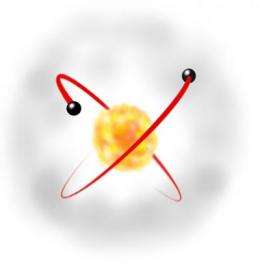New method knocks out stubborn electron problem

A newly published article in Physical Review Letters eliminates one of the top unsolved theoretical problems in chemical physics as ranked by the National Research Council in 1995. Scientists now can more accurately predict the dynamic behavior of electrons in atoms and molecules in chemical reactions that govern a wide range of phenomena, including the fuel efficiency of combustion engines and the depletion of the atmospheric ozone.
The paper by David Mazziotti, professor in chemistry at the University of Chicago, solves what specialists call the "N-representability problem." Robert Erdahl, a mathematician at Queens University in Canada and a leading authority on the N-representability problem, described Mazziotti's paper as "a striking advance," "an elegant theory," and "a remarkable achievement."
Research on the theoretical foundations of the problem has advanced significantly along two important but separate lines of research for more than 60 years, Erdahl noted. "Work in both directions has proceeded independently even though it was widely understood that a unified approach was required to achieve a clear understanding. However, no one has been able to construct a theory where both paths enter in partnership. In his recent work Mazziotti has achieved precisely that."
Molecules have anywhere from tens to thousands of electrons, and the computational complexity of simulating their behavior grows exponentially with the number of strongly correlated electrons, those whose motions are statistically linked to the motions of other electrons. Mazziotti's goal was to find a way to calculate the properties of many-electron systems via a two-electron technique, where the two electrons represent the other electrons in the system.
"The two-electron models provide a platform for exploring a whole range of chemistry and physics," Mazziotti said.
"If you are calculating, let's say, the water molecule, which has 10 electrons, your two-electron model has only two of the 10 electrons," Mazziotti said. "But the probability for finding those two electrons must be consistent with the other eight electrons in the real system."
The need for these consistencies, "What we call 'representability conditions,' are the necessary conditions that you really need to do two-electron calculations of many-electron molecules," he said.
Like minds
Three scientists independently proposed the idea of a two-electron model in the 1950s. One was A. John Coleman, a mathematician at Queens University in Canada, who presented the idea at a 1951 conference at Chalk River, Canada.
Two papers appeared in the journal Physical Review in 1955 making the same point. University of Chicago physicist Joseph Mayer authored one of the papers, while University of Florida chemist Per Olov Löwdin authored the other.
The search for these conditions later became known as the N-representability problem, following the terminology that Coleman had suggested in a 1963 paper published in Reviews of Modern Physics.
"Then there was a series of international conferences that were organized to search for these conditions," Mazziotti said.
An early confidence that researchers would work out the necessary conditions within a year or two gave way to despair in the late 1960s. By then it appeared that the previously unsuspected difficulty of the representability problem presented a potentially impossible barrier.
By the time the problem had come to Mazziotti's attention as a Harvard graduate student in 1995, the field had reached its nadir. In the early 2000s he began reviving interest in the problem with his formulation of mathematical procedures for some of the known conditions, and applying them for the first time to atoms and molecules.
Over the last 10 years, Mazziotti's steadily improving, two-electron models advanced chemistry research in ways not possible with the traditional equations of quantum mechanics.
"The thing is that we used partial N-representability conditions because we didn't know all of them," Mazziotti said. "We would never use all of them anyway, but it's one thing not to use all of the constraints. It's another thing not to know what they are."
Gap plugged
Mazziotti's Physical Review Letters paper plugs that gap, making the two-electron model a powerfully complete theory for mapping many-electron systems. "We can achieve much greater accuracy in our calculations by adding some of these new conditions that we've discovered," he said. "It's exciting because it's something I've been looking for since I started thinking about this in 1995."
Coleman, who died in 2010, said years ago that what inspired him to work on the N-representability problem was not the goal of computational efficiency or additional speed. It was instead the potential for tremendous new insight into how many-electron systems really work. "Ultimately, that is the driving force in my research, too," Mazziotti said.
More information: "Structure of Fermionic Density Matrices: Complete N-representability Conditions," Physical Review Letters.
Journal information: Physical Review Letters
Provided by University of Chicago

















